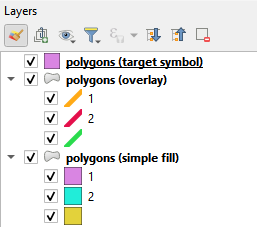A PyQGIS solution. Whether it can be considered simple is subjective, of course.
The layer tree
It contains the 'simple fill' layer, the layer with the overlaying symbol, and a third layer (duplicate of 'simple fill' layer) which will receive the merged symbol.
# the current project
p = QgsProject.instance()
# the layer with the simple fill symbology - change the name according to your project
lyr1 = p.mapLayersByName('polygons (simple fill)')[0]
# the layer with the overlaying symbology - change the name according to your project
lyr2 = p.mapLayersByName('polygons (overlay)')[0]
# a duplicate of either lyr1 or lyr2 (set to single symbol) - will receive the merged symbology - change the name according to your project
lyr3 = p.mapLayersByName('polygons (target symbol)')[0]
# get the renderer to merge
source_renderer = lyr2.renderer()
# clone the renderer from 'simple fill' layer ready to accept merged symbol
target_renderer = lyr1.renderer().clone()
# get categories of source and target renderers
cats_source = source_renderer.categories()
cats_target = target_renderer.categories()
# loop through categories and merge symbols
for i,cat in enumerate(cats_target):
# the symbol of the source layer
sym_source = cats_source[i].symbol()
# the symbol of the target layer
sym_target = cats_target[i].symbol()
# append the symbol layer from source to target
sym_target.appendSymbolLayer(sym_source.symbolLayers()[0])
# update the category's symbol
target_renderer.updateCategorySymbol(i, sym_target)
# apply the merged renderer to the target layer
lyr3.setRenderer(target_renderer)
# propogate changes to QGIS GUI
lyr3.triggerRepaint()
lyr3.emitStyleChanged()
Result
Warning
Run the script only once. Running it again will crash QGIS due to mismatches between the original and new symbols.


